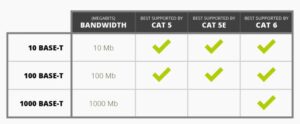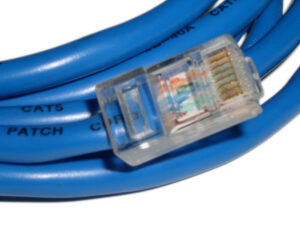Due to the endless need for faster internet speeds, different Ethernet standards that support varying speeds have evolved. Early Ethernet networking equipment’s were running at a speed of 10 Mbps. Later, 100 Ethernet, often referred to as fast Ethernet, was developed, supporting a speed of 100 Mbps. Ethernet technology continued to advance, supporting speeds of up to 1 Gbps and beyond.
In this article, we will explore 10/100 Ethernet, highlighting its speed, hardware infrastructure, and Use cases.
What is 10/100 Ethernet?
10/100 Ethernet is an Ethernet standard that supports both 10 Mbps and 100 Mbps internet speeds.
Different networking devices like network interface cards (NICs), LAN cables, or network switches are designed to adhere to an Ethernet standard, and one common feature is their backward compatibility.
Networking equipment developed to adhere to the 100 Ethernet standard can support 10 Mbps, which is the standard internet speed in 10 Ethernet (Ethernet). For instance, a 100 Ethernet switch can handle and support 10 Mbps traffic.
Ethernet standards are periodically reviewed and created by the IEEE (Institute of Electrical and Electronics Engineers). Once they release the standard, different network hardware vendors must upgrade their products to support the specification for such equipment to be labeled with the new standard.
The initial Ethernet standard; 10 Ethernet, was first created by IEEE in 1985. Later, in 1990s, due to the increasing need for higher internet speed, the 100 Ethernet standard was developed by IEEE, requiring all networking equipment to support 100 Mbps internet speeds.
Subsequently, other Ethernet standards, such as 1000 Ethernet (1 Gig Ethernet) and up to 100 G Ethernet, were released.
10/100 Ethernet Cable
Varieties of Ethernet LAN cables can support 10/100 Mbps Ethernet speeds. Popular 10/100 Ethernet cable used in many industries are Cat5, Cat5E & Cat 6. Stronger LAN cables like Cat5e and Cat6 are proffered as they provide greater reliability and support even higher speeds.

Source:truecable.com
Here is Cat5 LAN Cable, the perfect example of 10/100 Ethernet cable.

10/100 Ethernet Switch
In real-world networking, various Ethernet switches support the 10/100 Ethernet standard. Depending on the vendor your company is using, you can select their specific switch that adheres to the 10/100 Ethernet standard.
Typically, the Ethernet standard (speed) of any switch is specified on its body, such as 10/100 or 10/100/1000.
Here is an example of a 10/100 Cisco switch.

10/100 Ethernet Maximum Speed
The maximum speed for the 10/100 Ethernet standard theoriticall is 100 Mbps. However, achieving this maximum speed can be challenging due to inefficiencies in networking equipment like the LAN cable itself or the switch.
In practical scenarios, the maximum speed of 10/100 Ethernet will be around 80 Mbps.
Uses Of 10/100 Ethernet | Applications
10/100 Ethernet find application in home to medium-sized companies that does not need high speed internet access. 10 Mbps or 100 Mbps is normally enough bandwidth for such establishments. Here are some use case of 10/100 ethernet;
- Home Networking: The networking equipment usually found in homes is computers, gaming consoles, smart TVs, and streaming devices, and 10 to 100 Mbps is normally enough bandwidth for that.
- Small to Medium-sized Businesses (SMBs): SMBs often use 10/100 Ethernet for their local area networks (LANs) to connect workstations, printers, and other devices.
- Education: Schools and universities can use 10/100 Ethernet for their computer labs, classrooms, and administrative offices, providing reliable internet connectivity for students and staff.
- Healthcare: Healthcare facilities can use 10/100 Ethernet for connecting medical devices, patient record systems, and administrative computers, ensuring seamless data access.
- Hospitality: Hotels and restaurants can use 10/100 Ethernet for guest Wi-Fi access, reservation systems, and payment processing.
- Manufacturing: In manufacturing environments, 10/100 Ethernet may connect machinery, control systems, and production equipment, enabling real-time data exchange and control.
- Remote Offices: Branch offices of larger organizations may opt for 10/100 Ethernet to connect to the corporate network, especially if high-speed connections are not necessary.
10/100 Ethernet Vs. 1000 Ethernet
While 10/100 Ethernet serves as an ideal solution for home networking and small-to-medium-sized business networks, it’s essential to consider the advantages that 1000 Ethernet offers over 10/100 Ethernet.
In general, 1000 Ethernet supports internet access speeds that are ten times faster than the maximum speed achievable with 10/100 Ethernet.
Want more on 10/100 vs. 1000 Ethernet? Read our article on; 10/100 Ethernet Vs. 1000 Ethernet

I am a passionate Networking Associate specializing in Telecommunications.
With a degree in Electronic engineering, I possess a strong understanding of electronic systems and the intricacies of telecommunications networks. I gained practical experience and valuable insights working for a prominent telecommunications company.
Additionally, I hold certifications in networking, which have solidified my expertise in network architecture, protocols, and optimization.
Through my writing skills, I aim to provide accurate and valuable knowledge in the networking field.
Connect with me on social media using the links below for more insights.
You can contact me using [email protected] or connect with me using any of the social media account linked below



